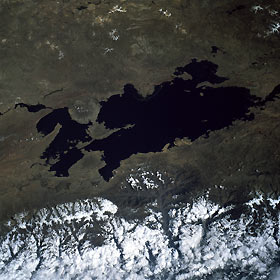
Save this image free of charge
in 800 pixels for layout use
(right click, Save as...)
|
|
Ref : T02347
Theme :
Looking at Earth - Rivers - lakes (517 images)
Title : Lake Titicaca, Bolivia and Peru May 1985
Caption :
Lake Titicaca, cupped in a depression in the Altiplano (high plains) between the eastern (cloud-covered) and western (not visible) ranges of the Andes Mountains, can be seen in this low-oblique, southwest-looking view. Covering an area of 3200 square miles (8290 square kilometers), Lake Titicaca is the largest freshwater lake in South America and, at 12 500 feet (3815 meters) above sea level, the world’s highest navigable lake. The lake is nearly 120 miles (190 kilometers) long, averages 45 miles (72 kilometers) in width, and has an average depth of nearly 900 feet (275 meters). The two basins of the lake are connected by the Strait of Tiquina. Fed by rainfall and meltwater from glaciers on the high peaks that border the Altiplano, Lake Titicaca is drained by the Desaguadero River, which flows south from the lake into Lake Poopó (not visible on the photograph). Traces of former shorelines ringing its basin reveal that Lake Titicaca was even larger in the past. At the end of the Ice Age, approximately 12 000 years ago, torrents of meltwater from the huge ice cap that once blanketed the Andes Mountains poured into a virtual inland sea known as Lake Ballivian. Its shoreline was about 150 feet (45 meters) above the present level of Lake Titicaca. Even today, the water level varies as much as 16 feet (5 meters) from season to season and year to year. Much of the present lake water is lost through evaporation caused by intense sunshine and strong winds. Numerous Indian villages, once the center of Inca Indian life, now crowd the lake shoreline. The constant temperature of the lake at 51 degrees Fahrenheit (11 degrees Celsius) modifies the climate and makes growing maize and wheat possible at such a high altitude.
|
|

